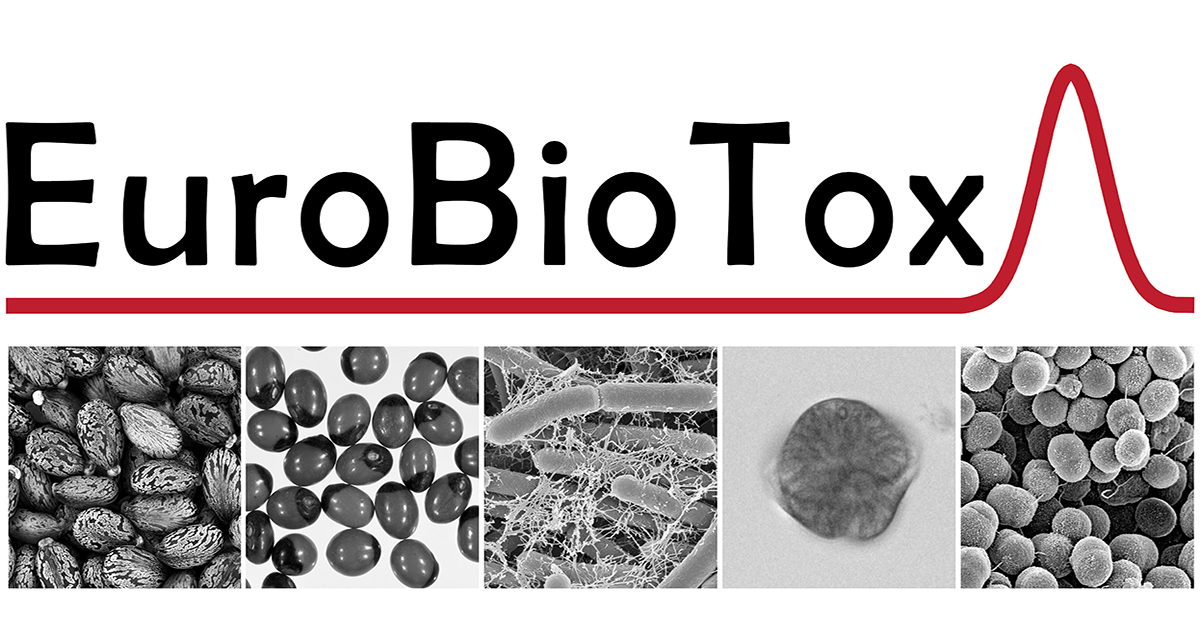The EuroBioTox Project: Progress Towards the Detection and Identification of Biotoxins via Standardization, Training, and Method Evaluation
A special issue of Toxins (ISSN 2072-6651).
Deadline for manuscript submissions: 31 October 2026 | Viewed by 4158

Special Issue Editors
Interests: botulinum neurotoxin; ricin; tetanus neurotoxin; Clostridium perfringens; Clostridium botulinum; Staphylococcus aureus enterotoxin (SE)
Special Issues, Collections and Topics in MDPI journals
Interests: botulinum neurotoxins, ricin, abrin and other protein biotoxins; variability and functionality of biotoxins; (multiplex-) detection of biotoxins; antibodies for research and therapy
Special Issues, Collections and Topics in MDPI journals
Special Issue Information
Dear Colleagues,
Recent incidents in Europe have highlighted that terrorists take an interest in the production of biotoxins, and that they have even succeeded in the production of toxic material. Previous studies have shown that there is a lack of robustness in Europe’s preparedness for biotoxin incidents. Therefore, the EuroBioTox project—funded under the EU’s Horizon 2020 program—consolidated an expert network comprising 63 institutions from 23 countries to strengthen Europe’s capabilities to cope with the intentional release of biotoxins, namely, saxitoxin, ricin, abrin, Staphylococcus aureus enterotoxin B (SEB), and botulinum neurotoxins (BoNTs).
EuroBioTox produced the world’s first ISO 17034:2016 certified reference materials (CRMs) for protein biotoxins relevant in the security field. This Special Issue describes the comprehensive characterization of CRMs for ricin, abrin, BoNT/A, BoNT/B, and SEB, which are now available to authorised expert laboratories worldwide. The CRMs significantly increase quality assurance measures in the field of biotoxin detection and allow for the development and comparative validation of novel methods, particularly animal replacement methods, which are still in place for some of the mentioned biotoxins. The CRMs also serve as analytes in a series of large international proficiency tests (PTs) organized by the EuroBioTox consortium to demonstrate the technical progress in biotoxin detection, identification, and quantification. First, previously recommended detection methods were trained and subsequently employed in the PTs. This approach resulted in a clear improvement in the analytical results obtained in a two-stage PT scheme. In the absence of regular self-assessment, the PT scheme offered participants an opportunity to self-evaluate their analytical capabilities and to obtain or maintain an accreditation.
With respect to animal replacement methods for the detection of BoNTs, a comprehensive study evaluated the performance of in vitro and ex vivo methods on a wide panel of samples comprising C. botulinum neurotoxin sero- and subtypes spiked into representative clinical, food, and environmental matrices. The results highlighted superior animal replacement methods, which will help reduce animal experiments in the field of botulism diagnostics, directly supporting Directive 2010/63/EU on the protection of animals.
A review article in this Special Issue summarizes the major achievements of the EuroBioTox project, putting them into context, and sheds light on the future avenues for biotoxin detection.
Dr. Andreas Rummel
Dr. Brigitte G. Dorner
Guest Editors
Publisher’s notice:
As stated above, the central purpose of this Special Issue is to present research from the EuroBioTox Project. Given this purpose, the Guest Editors’ contribution to this Special Issue may be greater than outlined in MDPI’s Special Issue guidelines (https://www.mdpi.com/special_issues_guidelines). The Editorial Office and Editor-in-Chief of Toxins has approved this Topic and MDPI’s standard manuscript editorial processing procedure (https://www.mdpi.com/editorial_process) will be applied to all submissions. As per our standard procedure, Guest Editors are excluded from participating in the editorial process for their submission and/or for submissions from persons with whom a potential conflict of interest may exist. More details on MDPI’s Conflict of Interest policy for reviewers and editors can be found here: https://www.mdpi.com/ethics#_bookmark22.
Manuscript Submission Information
Manuscripts should be submitted online at www.mdpi.com by registering and logging in to this website. Once you are registered, click here to go to the submission form. Manuscripts can be submitted until the deadline. All submissions that pass pre-check are peer-reviewed. Accepted papers will be published continuously in the journal (as soon as accepted) and will be listed together on the special issue website. Research articles, review articles as well as short communications are invited. For planned papers, a title and short abstract (about 100 words) can be sent to the Editorial Office for announcement on this website.
Submitted manuscripts should not have been published previously, nor be under consideration for publication elsewhere (except conference proceedings papers). All manuscripts are thoroughly refereed through a double-blind peer-review process. A guide for authors and other relevant information for submission of manuscripts is available on the Instructions for Authors page. Toxins is an international peer-reviewed open access monthly journal published by MDPI.
Please visit the Instructions for Authors page before submitting a manuscript. The Article Processing Charge (APC) for publication in this open access journal is 2700 CHF (Swiss Francs). Submitted papers should be well formatted and use good English. Authors may use MDPI's English editing service prior to publication or during author revisions.
Benefits of Publishing in a Special Issue
- Ease of navigation: Grouping papers by topic helps scholars navigate broad scope journals more efficiently.
- Greater discoverability: Special Issues support the reach and impact of scientific research. Articles in Special Issues are more discoverable and cited more frequently.
- Expansion of research network: Special Issues facilitate connections among authors, fostering scientific collaborations.
- External promotion: Articles in Special Issues are often promoted through the journal's social media, increasing their visibility.
- e-Book format: Special Issues with more than 10 articles can be published as dedicated e-books, ensuring wide and rapid dissemination.
Further information on MDPI's Special Issue policies can be found here.







